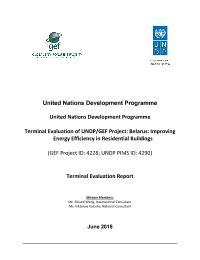
Terminal Evaluation of UNDP/GEF Project: Belarus: Improving Energy Efficiency in Residential Buildings
Output 1.5. Inclusive and sustainable solutions adopted to achieve increased energy efficiency and universal modern energy access (especially off-grid sources of renewable energy)
Goal 4. Ensure inclusive and equitable quality education and promote lifelong learning opportunities for all
Goal 7. Ensure access to affordable, reliable, sustainable and modern energy for all
4.7 By 2030, ensure that all learners acquire the knowledge and skills needed to promote sustainable development, including, among others, through education for sustainable development and sustainable lifestyles, human rights, gender equality, promotion of a culture of peace and non-violence, global citizenship and appreciation of cultural diversity and of culture’s contribution to sustainable development
7.2 By 2030, increase substantially the share of renewable energy in the global energy mix
7.3 By 2030, double the global rate of improvement in energy efficiency
1: Environment & Sustainable Development
2: Others


